CORRESpoNdENT'S CORNER: ThE
HAllE EXpEdiTiON
by MAREk ToMCzyk, AC STAff CORRESpONdENT, GERMANy
Brave New World
For the first time in my life, I decided to cross what used to be the border of the former East Germany. My destination: Halle, halfway between Berlin and Erfurt. Starting point: Central Station in Stuttgart, southwestern Germany. A long, white InterCity Express (ICE) majestically leaves the platform, carrying me north in a comfortable seat with onboard audio programs.. I soon forget about the landscape flying by at 155mph outside the window.
Now there's time to relax and look at the orange leaflet in my hands. It's an invitation for "Die 2. Atari XL/XE Messe" (2nd Atari XL/XE Fair) in Halle, on Saturday, April 3, 1993. Unbelievable! An all-Atari XL/XE fair nowadays? The invitation promises great things: a big computer and sales presentation with all major 8-bit dealers, clubs, and programmers in attendance; a game competition; an "Atari-Museum" with rare products; many oldies to buy, and last but not least you certainly won't starve there.
On the back side of the invitation is a map of Halle and its surroundings and some details on how to find the meeting place. Below the map are phone numbers for people seeking accomodations. The organizers even provided a "hot line" for people who got lost on their way to the meeting. I was impressed with the obvious amount of planning that went into this show.
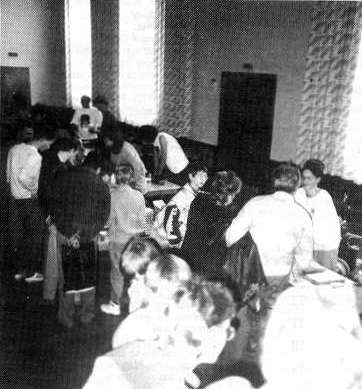
Some of the Halle festgoers in action. Barely visible on
the table at the extreme right of the photo is a copy of AC.
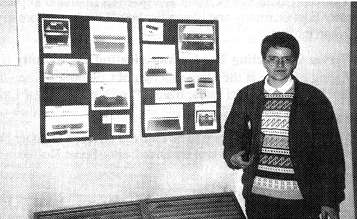
ACs German Correspondent Marek Tomczyk pauses in the
foyer of the Klubhaus der Waggonbauer in Halle beside
posters featuring rare Atari 8-bit hardware.
My curiosity about this fair had been raised to a fever pitch as a result of all the publicity it had received. Earlier in the year, TOP-Magazin and the ABBUC newsletter had announced the fair and asked for contributions to a planned demo-disk called "The Halle Project". This demo was intended to be a continuation of the old "Hobbytronic" demos. The two fairs held at Halle- including this one- were both organized by TOP-Magazin.
A German Safari
I had to leave the hi-tech ICE and continue my 350mile journey on an ordinary InterCity train. As the train entered the area of Germany which had once been hidden behind the Iron Curtain, I experienced a growing sense of anxiety and anticipation. Suddenly the train began to shake and vibrate, and the scenery outside changed abruptly. I knew I was there, not only because of the bad track. The InterCity passed through wide agricultural areas and advanced slowly between the gray, shabby houses dotting the landscape of the former German Democratic Rupublic.
One more time I changed trains. This one was so rickety I feared it might disintegrate when I opened the door! Anyway, after almost 8 hours of jostling on the rails I decided to stop over in Weimar, home town of the great poet Johann Goethe. Next day I continued my trip by car. The remaining 100 miles went fairly smoothly when I finally arrived in Halle. The parking lot adjacent to the meeting place promised lots of visitors from all over the country.
The Fair At Last!
As I entered the "Klubhaus der Waggonbauer" where the fair was being held, I was pleasantly surprised to see that entry to the fair was free. I went in and... WOW!!! An entire hall full of 8-bit Ataris, lots of people crowded around booths, a cacophony of sound emanating from various XL/XEs showing demos, people chatting and haggling. I paused at the entrance to survey the meeting area.
The whole place was about the size of a gymnasium with stalls along the walls leaving an open space in the middle for all the 8-bit devotees. Unable to decide what to see first, I just mingled with the crowd. The first thing I noticed about this fair was that people weren't just walking and talking. Sometimes lively discussions arose spontanously, very often resulting in people exchanging addresses for future contacts.
8-Bit Warmups
The first stall I came to belonged to the "TOPCrew", the fair organizers. They were hard at work showing and selling the "Halle Project" demo-disk. Just the right subject to start a conversation! Parts of the demo were being written right there at the show, and they didn't mind people plying them with questions about tricky machine language programming. It turned out that many programmers devoted to demo programing were using a relatively new (Shareware) Assembler by Torsten Karwoth supporting more than 64K RAM. Another product sold at this stall was of course the 8-bit TOP Magazin, a disk-based magazine published by the "TOP-Crew".
I moved on to other booths. On the left near the entrance, a PD/Shareware distributor opened his business. He was either very successful or not wellprepared for the show: by 11AM he was out of blank disks!
Hardware Wonderland
Next to the diskless PD vendor was perhaps the most interesting booth at the show. Klaus Peters and Co. presented a mix of new and existing products with an emphasis on hardware. In revision III already, the 1-meg memory upgrade with 10-bit hardware refresh and two 4-megabit DRAMS offered huge memory on a tiny, professional PCB. If you got bored with RAM upgrades you could check out Klaus's ROM upgrade. His 512K ROMdisk allows you to access your favorite software burned on EPROMS. The ROMdisk plugs into the PBI, and even lets you boot from it. Of course, a ROMdisk is rather useless if you don't have the means to burn your own EPROMS. Not to worry, Klaus was happy to sell you his "Burner XL/XE" which connects to the cartridge port and burns EPROM types up to 27512's
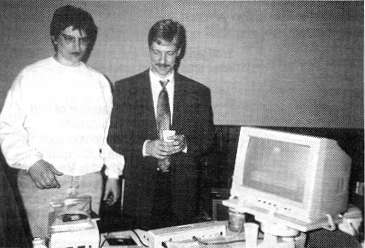
Representatives at the Klaus Peters Elektronik+Software
booth demonstrate the latest hardware upgrades.
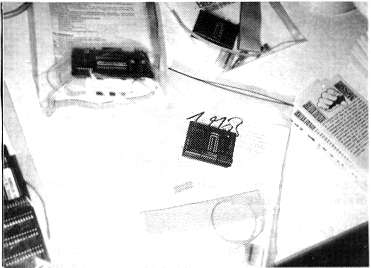
Goodies from Klaus Peters. In the center is the Peters
'MegaRAM' 1-meg upgrade board using just two 4-meg
DRAMS. In the upper left Is the 25K Bibomon upgrade
OS replacement. Partly cut off in the lower left is the
512K ROMdisk. Yum, yum!
Another interesting hardware upgrade from Klaus Peters is the 25K Bibomon. It has an onboard M/L monitor, a simple assembler, a sector editor, various DOS functions and lots more. Besides the supplied modified XL/XE OS it also allows you to use the old 400/800 OS. There's even a space on the PCB where you can plug in two additional OS's of your choice. The OS's and other functions are accessed via a colorful menu.
Atari doesn't produce the XF551 any more, but Klaus sells a substitute for it: the "Floppy 2000". This double sided, double density 5.25" drive connects to the SIO just like other Atari peripherals. It comes in a gray slimline case with a built-in speed enhancer and the ability to reprogram the drive to a certain extent.
It wasn't all hardware, Klaus had software as well. "Sprint XL", a DTP program for the 8-bit, is roughly comparable with "Daisy Dot". "Sprint XL" uses character sets "E24" in the SIGNUM format (SIGNUM is a DTP program for the Atari ST). It lets you incorporate graphics in your text and supports formats from the common 62-sector Gr. 8 pictures to the ART format used on PC's. I chatted with several people who used both "Sprint XL" and DD3. Some liked DD3 better than "Sprint XL" while others claimed just the opposite. Klaus was selling some older software, too. Mainly games like "F-15" and "Guild of Thieves".
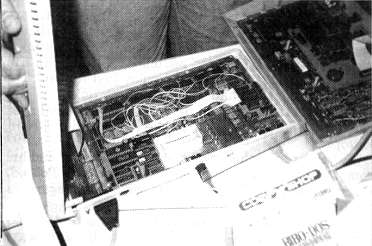
The Peters MegaRAM installed in an 800XL
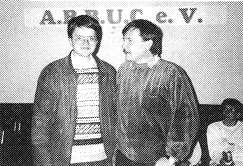
AC meets ABBUC. ABBUC's President
Wolfgang Burger (right) with AC's
representative Marek Tomczyk (left).
The Show Goes On
The next booth was Kemal Ezcan with his company called KE-Soft. This company is based around the 8bit magazine ZONG. Besides this bimonthly magazine he sells a bunch of games including his own productions as well as imports from Poland and the U.S. Action! could be yours for 289DM while M.U.L.E. went for 79DM. [Editor's Note: the German Deutschmark (DM) is worth roughly US$0.60, or about 3DM to the British pound sterling. Assuming l've done the currency conversion correctly, these prices would be considered outrageous in the U.S. -BP] KE-Soft conducted the announced game competition for kids. The challenge was to solve an adventure game controlled by a touch tablet.
Adjacent to KE-Soft, the all 8-bit usergroup ABBUC (Atari Bit Byters User Club) offered membership info for those wishing to add their names to its 750 members worldwide. Visitors could play with a video digitizer they had connected to a video camera through the cartridge port of an 800XL. The Atari displayed about three GRAPHICS 8 pictures per second, which was amazing. Anyone could freeze the desired picture and save it to his disk.
On the other side of the hall another user club from Bremen (northern Germany) was selling reconditioned hardware and old software items. You could spot some small hardware hacks as well, especially a "Lightshow" with an array of LEDs.
Halle Goes International!
It was true. Alphasys from Holland found their way to Halle, too! Besides the usual software, they offered a 130XE built into a huge tower case. This beast had a second POKEY for playing music in stereo. The Alphasys guys promised new sound digitizing software to support expanded RAM and simplify sound mixing. Alphasys' tower XE was really a showpiece: equipped with numerous LEDs and switches, a 1050 with the Speedy upgrade and a speed display just for fun. On another table they had a C.S.S. Black Box from the U.S. connected to a hard drive. This was a ral eyecatcher for many fairgoers, as the BB is rather rare in Europe.
Adjacent to Alphasys was Markus Roessner and his company selling a huge variety of games from Poland, Germany and the U.S. as well as some disk magazines like MegaMagazine and ZONG.
The next booth hosted some very young and skilled programmers of "W.A.F.", the "Wuerzburger Atari Front". W.A.F. is a regional group of ABBUC known for some excellent demos in the past. They showed their part of the "Halle Project" demo and just represented their Club.
That's also what their neighbors did, i.e. another regional division of ABBUC. They came from Osnabrueck and and demonstrated their OS replacement called SPOS. SPOS is a single EPROM with a new OS on it. For 39DM it offers massive RAMdisk support allowing you to boot from the RAMdisk. A special keypress brings you to a menu where you can chose SPOS's functions. This group's table held another interesting device not seen in the U.S.: the HDI. HDI is a stand-alone 3.5" 1.44MB disk drive connected to the standard SIO. It was developed by a member of ABBUC whose name has now regrettably slipped my memory. During the show the HDI ran under MyDOS and served as an archive for various demos. It has a cable allowing you to connect additional standard 3.5" slave drives.
Overveiw
The Halle fair was a great success, with about 300 8-bit aficionados attending this one-day event (more than last year). I asked the organizers how they came out financially. They didn't anwser directly but indicated they at least managed to break even. One part of their income derived from sales of the "Halle Project" demo disks, with a boost from food sales (they offered the famous "Thueringer Bratwurst"). Their strategy appeared successful. The Halle fair really has become a replacement for the former "Hobbytronic" fair, which became desolate over the last few years and is no longer relevant for Atari 8-bit users.
This fair was just the opposite. Despite the fact that none but insiders deal with our beloved 8-bits these days, the fair managed to attract a growing number of visitors. I'm sure everyone will cherish a fond memory of this Saturday, which was far more than a commercial presentation.
I really hope this fair will continue in years to come; maybe it could become even more international since now you all know about it! Auf wiedersehen!

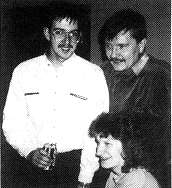
Wolfgang Burger and members
of ABBUC relax after a successful day in Halle.
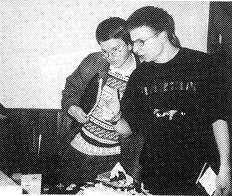
A member of the Osnabrueck Regionalgruppe
of ABBUC explains the SPOS to Marek. In the
foreground at bottom center is the HDI 1.44meg
SIO floppy drive with case removed for demonstration.